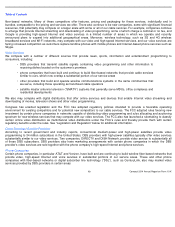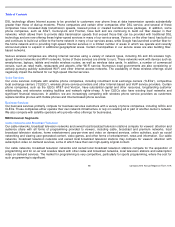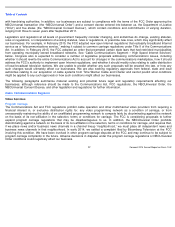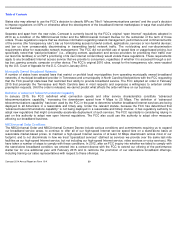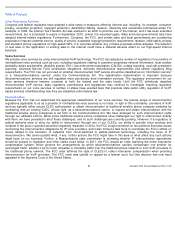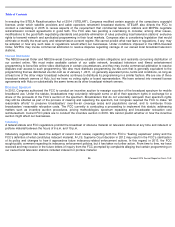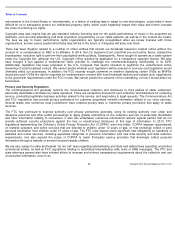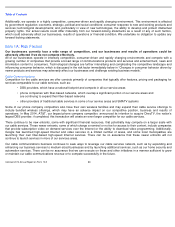Comcast 2014 Annual Report Download - page 26
Download and view the complete annual report
Please find page 26 of the 2014 Comcast annual report below. You can navigate through the pages in the report by either clicking on the pages listed below, or by using the keyword search tool below to find specific information within the annual report.
Table of Contents
Other Regulatory Activities
Congress and federal regulators have adopted a wide range of measures affecting Internet use, including, for example, consumer
privacy, consumer protection, copyright protection, defamation liability, taxation, obscenity and unsolicited commercial email. For
example, in 1998, the Internet Tax Freedom Act was enacted in an effort to promote use of the Internet, and it has been extended
several times, but is scheduled to expire in September 2015, unless it is extended again. State and local governments also have
adopted Internet-
related regulations. Furthermore, Congress, the FCC, and certain state and local governments are considering
proposals to impose customer service, quality of service, expanded copyright protection requirements, taxation, child safety, privacy
and standard pricing regulations on high-
speed ISPs. It is uncertain whether any of these proposals will be adopted. The adoption
of new laws or the application of existing laws to the Internet could have a material adverse effect on our high-
speed Internet
business.
Voice Services
We provide voice services by using interconnected VoIP technology. The FCC has adopted a number of regulations for providers of
nontraditional voice services such as ours, including regulations relating to customer proprietary network information, local number
portability duties and benefits, disability access, E911, law enforcement assistance (CALEA), outage reporting, rural call completion
reporting, Universal Service Fund contribution obligations, domestic discontinuance requirements and certain regulatory filing
requirements. The FCC has not yet ruled on whether interconnected VoIP service should be classified as an “information service”
or a “telecommunications service”
under the Communications Act. The classification determination is important because
telecommunications services are still regulated more pervasively than information services. The regulatory environment for our
voice services therefore remains uncertain at both the federal and the state levels. Until the FCC definitively classifies
interconnected VoIP service, state regulatory commissions and legislatures may continue to investigate imposing regulatory
requirements on our voice services. A number of states have enacted laws that preclude state public utility regulation of VoIP-
based services notwithstanding how they are classified under federal law.
Interconnection
Because the FCC has not determined the appropriate classification of our voice services, the precise scope of interconnection
regulations applicable to us as a provider of nontraditional voice services is not clear. In light of this uncertainty, providers of VoIP
services typically either secure CLEC authorization or obtain interconnection to traditional wireline phone company networks by
contracting with an existing CLEC, whose right, as a telecommunications carrier, to request and obtain interconnection with the
traditional wireline phone companies is set forth in the Communications Act. We have arranged for such interconnection rights
through our affiliated CLECs. While some traditional wireline phone companies have challenged our right to interconnect directly
with them, we have prevailed in all of these challenges, and no such challenges are currently pending. However, if a regulatory or
judicial authority were to deny our ability to interconnect through one of our CLECs, our ability to provide voice services and
compete in the area in question would be negatively impacted. In 2012, the FCC sought comment on two petitions that raise issues
concerning the interconnection obligations for IP voice providers, and it also formed a task force to coordinate the FCC’
s efforts on
issues related to the transition of networks from circuit-switched to packet-
switched technology, including the issue of IP
interconnection. We cannot predict what, if any, further actions the FCC might take in this area or what effect any such actions
might have on our business. Further, a Massachusetts state commission is reviewing whether IP interconnection agreements
should be subject to regulation and other states could follow. In 2011, the FCC issued an order clarifying the entire intercarrier
compensation system, which governs the arrangements by which telecommunications carriers compensate one another for
exchanged traffic, whether it be for local, intrastate or interstate traffic over the traditional phone network or from VoIP providers to
the traditional phone network. The FCC order affirmed the right of CLECs to collect intercarrier compensation when providing
interconnection for VoIP providers. The FCC order was upheld on appeal by a federal court, but that decision has now been
appealed to the Supreme Court of the United States.
21
Comcast 2014 Annual Report on Form 10
-
K




